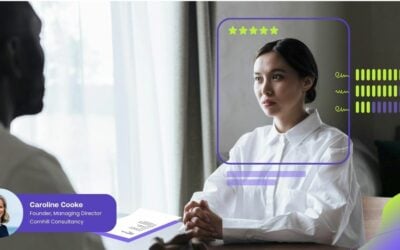
Pre-recorded video interviews are coming for all of us! AND I MEAN ALL OF US.Hide your mother, hide your dog, and hide the absolute MESS of a room you’re reading this in right now.
Oh, you thought we were joking? No. We are being quite serious (with a touch of drama because we LOVE your attention).
The era of tedious, suffocating in-person interviews is slowly dying off (good riddance!) while online and pre-recorded interviews are becoming more commonplace around the world.
If you’ve never sent in a pre-recorded interview video (also known as a one-way interview), this blog is for you! And if you HAVE sent in a pre-recorded interview but weren’t satisfied with the results, this blog is … also for you.
Let’s get started.
What are pre-recorded interviews?
Over recent years, video interviews have become a staple in the hiring process of companies across the globe. While regular live video interviews (“online”) are pretty much similar to in-person interviews (with a few crucial differences), pre-recorded interviews are a different ball game.
In a pre-recorded interview, an employer will usually provide you with the necessary details on how to “attend” the session. For example, they may require you to use a particular platform and record your video ON that platform, or they may ask you to just record a video and upload it instead.
During this interview, the employer may provide you with a set of questions (either beforehand or as soon as you log into their platform of choice, etc.). You will have to answer these questions within an appropriate or chosen time frame, so be careful not to ramble on and try to articulate to the best of your abilities.
If it is via a platform, it will prompt you to complete your response within the time limit, and if you’re not satisfied with your answer, you may get the opportunity to re-record.
There is also a slight chance that your employer might provide you with a small task during these sessions but that’s rare. Usually, these videos help the company get introduced to the candidate rather than make them complete tasks on the spot.
So, let’s talk about how you should prep for the recording.
The visuals
Before you log in or begin recording, there are several quick steps you must take to ensure your “interview” goes smoothly (and that you look good doing it).
1. Clean up: Who among us has never had to put up with unsightly clutter in our lives? Well, there is no reason to treat our potential employers to it, too. You want to present yourself in a professional manner, so make sure that any dust and dirt in at least the camera’s line of sight is cleaned up. Put away your clutter if you’re not up for throwing it out.
A neutral background would be brilliant. Give your surrounding some “space to breathe”. Don’t position yourself against a wall with tons of posters, for example. Get like Taylor and go for that Blank Space.
2. Follow the light: Wait, we can explain. Something we’ve noticed repeatedly is that a lot of candidates don’t pay attention to the lighting in their videos. This can be a bit of a problem as one, it shows oversight or lack of care, and two, you tend to look drawn/tired with poor lighting, which may make the employer lose interest in your video.
You want to retain their attention, you want to leave a mark, and you want to show them you are the best person for this role. A well-lit video can go a long way in cementing this image.
Natural light is the first contender. In this context, natural light usually comes from the windows. You want to make sure that the light is falling on your face and not against your back, so you would be sitting facing the window.
Now, this also depends on what time of day it is. If the light is seeping into your room from an angle, adjust yourself accordingly. Now, you’ll also have to keep in mind that light reflects off glasses and jewellery, so you’ll want to either take off flashy jewellery or adjust the light so it doesn’t hit your glasses in a way that covers your eyes.
If this is not possible, consider using a lamp or other source of artificial light to balance out the shadows. You can check this video out for more information on lighting while recording at home.
3. Get lifted (NOT LIKE THAT!): How would you feel watching a video where the other person is staring down their nose at you? Not very pleasant, isn’t it? Eyes should meet eyes (unless that makes you uncomfortable but that’s a different question). It’s a sign of mutual respect and acknowledgement of the other person’s presence.
If you want to get your points across and be heard, you need to have a conversation with the employer. You can’t do that if the angle is so weird that it makes the other person feel like they’re straining to look up or down at you.
If you’re at a desk, and the chair is too low, you’ll want to pad it up so your webcam, phone or camera matches your eye line. Aim for right above the eyebrows, if possible. This would be the ideal angle (so that it doesn’t look like you’re staring directly into the camera and stealing the souls of the viewer/s).
Alternatively, if you’re seated too high from the camera’s line of sight, then you’ll have to utilise some tools to lift it higher. For example, use a stack of books to bring your laptop higher, or a table-top tripod for your phone, if you’ve got one.
4. Glowing up: Whether you had your personal glow-up or not doesn’t really matter in a work environment, but a professional glow-up is a whole other situation. This is still an interview, even if you’re doing it at home.
Choose clothes that will flatter you but make sure not to make them too flashy. For example, sequins and snap fasteners are great for a night out, but as this is a video interview, it’ll be way too distracting and steal your spotlight.
Literally, it WILL steal light over your face and then, your job, too. Is that what you want? Sequins for president? (We’re getting ahead of ourselves …)
We don’t like policing clothes over here at Capital Placement, but we do recommend you dress in what you think would impress your potential bosses but maintain your own personal flare if you wish.
Usually, something semi-formal will work for most jobs, but some really do require you to don a suit (urgh) and that really can’t be helped. So, just check out the company and see if you can figure out what kind of dress code would suit the situation most.
The hard part
Okay, so believe it or not, that was the easy part, but don’t worry. The rest of it just takes a little effort and then, it’ll be smooth sailing. Here are some things you need to keep in mind before starting your recording:
1. Testing 1, 2, 3: You want to make sure you’re actually recording things properly. You don’t want to sit there, talking away, only to realise at the end (or if you’ve sent it in, far too LATE) that your mic wasn’t even picking up your voice!
Do a mic check before (and during, if possible) recording to ensure that the volume and quality of your voice are at optimum levels. If issues persist, you’ll have to find a workaround.
Now, the next culprit is noise pollution. There isn’t much you can do about noise pollution in general, but if it can be helped, try and reduce it as much as possible.
See, when I had my first interview, my fan was so noisy, that the interviewer was concerned somebody was getting beaten up. I switched it off, but it was too late. I’d distracted the interviewer to the point where they weren’t able to pay attention to what I was saying.
You don’t want that. Find a quiet place, identify sources of noise pollution and try to eliminate them. Unless the noise pollution is coming from a child … in which case, please don’t. Just … give them a game or candy and request them kindly to be quiet for a few minutes.
2. What to say: The key points that you need to summarize are who you are, what you do, why you do it and how you do it. Don’t give the interviewer your whole life story. This isn’t a college application. It’s a job.
Your employer doesn’t need to know that your dog passed away and this made you want to become a data analyst because “data never dies”. Stick to the essential facts. Summarize it; succinctly, concisely, and every other synonym in the thesaurus that means KEEP IT SHORT.
You can make this easier by mapping out your talking points. Write out some basic bullet points and make sure the conversation flows sensibly. It’ll help you keep tabs on points you don’t want to miss and eliminate time-wasters early on.
If you’ve already been provided with interview questions, then use this system to do the same. Write out the questions and add some BASIC bullet points under them to highlight your talking points.
Next, do some dry runs. Don’t dive into the recording as soon as you’re done writing. Read it out loud and try to answer these questions beforehand. You’ll notice where you get stuck or where you stop making sense. Fix these issues then and there before you move on.
3. Mind your body language: *flips table* We can’t stress this enough. Your body language is VERY IMPORTANT. Unless you’ve actually got chronic back pain (I do, so I get it), sitting hunched over or slouching in front of the camera isn’t going to do you any favors.
At the risk of sounding like a teacher, please sit up straight. You want to show the employer that you are confident in your capabilities, but your body can easily betray your words if you’re not careful. Check out our short video on some key body language do’s and don’ts in interviews for some quick tips!
Final thoughts
Now that you’ve gotten all the technical bits out of the way, relax. Take a deep breath. Remember, you’ve got this. You’re selling yourself and your confidence will be a key factor in how well you portray yourself.
And please eat something beforehand so you don’t get too lightheaded while recording. Trust us, it works to have a happy belly. Your brain will thank you!
Don’t forget to READ UP on the company and pay close attention to the details in their brief and the job description. Utilize the keywords they use to describe yourself so that you have a better chance of aligning yourself with the company’s needs and wants.
If you’d like to learn more about how to dance around even the most difficult interview questions, we’ve got a blog to help you ace every round of questioning!







